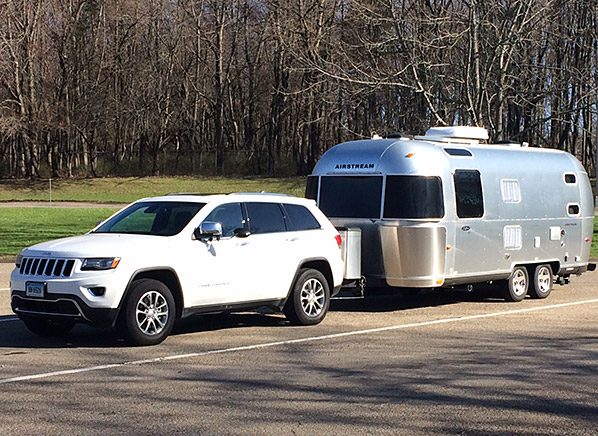The Safety Feature That Saved My Bacon

Consider me a convert. I’m 100-percent convinced that a forward-collision warning system (FCW) prevented my wife and me from having a serious high-speed crash. Having experienced the benefits of this advanced safety technology first-hand, I’m furious that it isn’t on more cars and offered at a lower price.
Here’s what happened: A few weeks ago, my wife and I were on a four-lane Massachusetts freeway, returning from a weekend of camping with Consumer Reports’ 2014 Jeep Grand Cherokee EcoDiesel and pulling an Airstream trailer. I was just tooling along in the slow lane, and wondering if I should take the next exit or not. This was a clear, dry road that ran straight ahead of me, down into and back up a dip, with nearly ¾-mile of clear visibility.
My wife was tapping busily on her iPhone, trying to get a fix on traffic congestion. Pilots call it “situational awareness,” and mine was lost. While staring at the traffic stopped way ahead of me at the exit, I didn’t realize that it had also backed up nearer to me, filling up the lane ahead.
A loud “BEEP BEEP BEEP” yanked my gaze down to the dashboard. Time slowed down, like in a movie. My wife yelled, “What’s that?!” A big red “BRAKE!” appeared across the entire digital instrument display. I looked up to see that right ahead of me, a car sat directly in my path, and I was closing in way too fast.
Now I had to quickly stop 11,000 pounds of Jeep and Airstream. (The Jeep’s crash mitigation auto-braking might have helped some, but the system wasn’t going to stop it completely.) I jumped on the brake pedal hard and then backed off a little to keep from locking the trailer’s electric brakes. We stopped, but with little room to spare.
This experience convinced us that we would never buy a new car without FCW. Indeed, my wife’s 2011 Dodge Durango has this safety gear. But prioritizing this technology can force a big added cost.
The FCW system on Consumer Reports’ $49,780 Jeep Grand Cherokee was a $1,995 option, bundled into an “Advanced Technology Group” package along with adaptive cruise control, lane departure mitigation, and blind-spot warning. To get that package, you also need to get the $3,000 Luxury Group II package, and you can’t get it on a trim level below Limited. Turns out, such price-based restrictions are typical. Very few cars have forward-collision warning standard, and most force you to get expensive options, often on top of a high-end trim level.
[one_fourth]
[/one_fourth]I’m far from alone in supporting forward-collision warning. Highway Loss Data Institute data show that FCW, packaged with lane-departure warning, reduced crashes on Honda Accords and Crosstours by 14 percent. Coupling FCW with auto-braking, which works to prevent or lessen the severity of crashes, can even further reduce insurance claims. Accordingly, a front crash protection system with effective auto-braking, as proven effective in Insurance Institute for Highway Safety (IIHS) testing, is required to earn their 2015 Top Safety Pick+ rating. Vehicles with basic FCW systems without effective auto-braking can qualify for Top Safety Pick status, sans the plus sign.
What cars make FCW affordable, or at least easy to find on a dealer’s lot?
- Probably the least expensive car with the system is the Chevrolet Sonic; it’s a $395 option on LT and LTZ trim. Most other Chevrolets offer FCW as part of an Advanced Safety Package for around $900, once you get the mid-level 2LT or top LTZ trim.
- Honda makes finding FCW easier than most. Get any Accord, Crosstour, or Odyssey with leather and you get the system.
- Most Acuras, Honda’s luxury brand, also have FCW. It’s standard on the RLX and included in the Technology package bundled with most Acuras on dealers’ lots.
- Subaru’s optional EyeSight suite of electronic safety equipment includes FCW. It’s available on popular mid-level versions of the Forester, Legacy, and Outback, and the top-trim Impreza Limited.
- While Volvo makes their City Safety system standard on all models, a system that automatically brakes to avoid rear-end collisions under 30 mph, full FCW remains optional. (Volvos still qualify for the IIHS Top Safety Pick+ status, even without the option.)
As the IIHS continues to ratchet up their threshold for vehicles earning good ratings, more cars will adopt this technology. For example, Toyota publically announced that they will make FCW available on more models at a lower price. But consumers need to realize that buying a car that fully qualifies for Top Safety Pick+ status usually requires purchasing optional equipment. We wish more manufacturers would make that easier.





